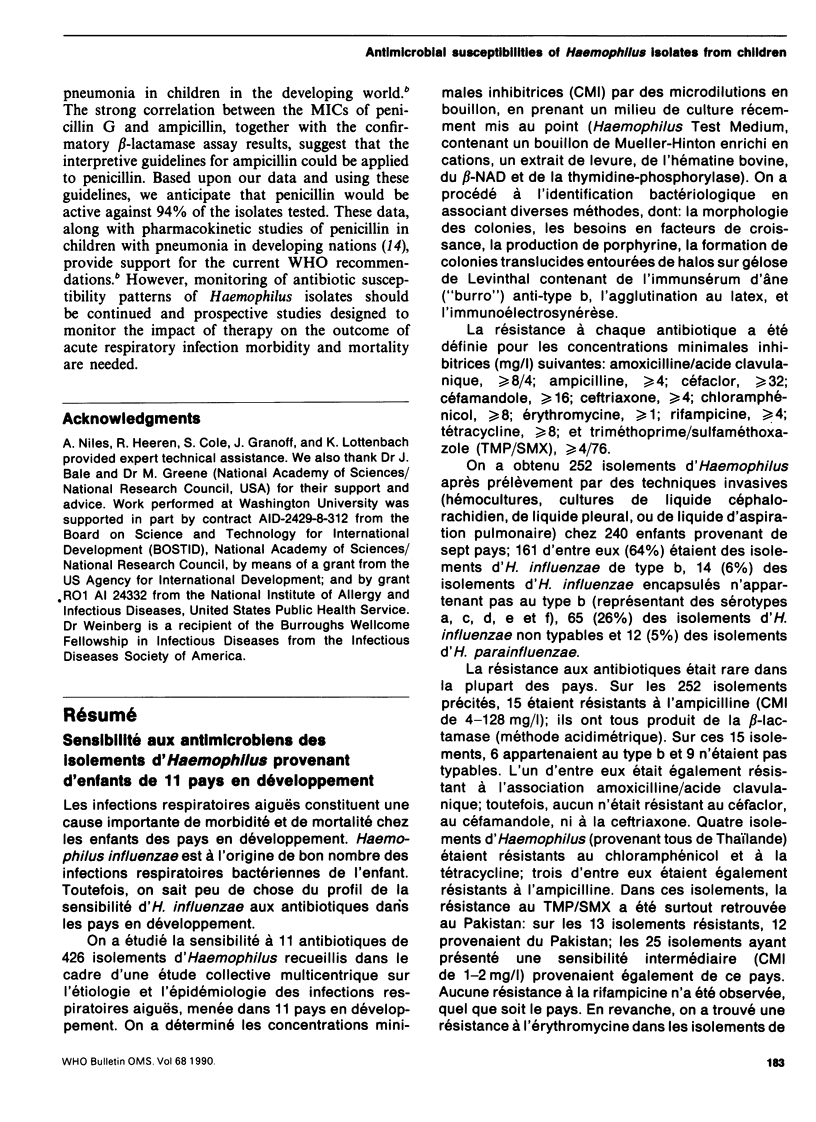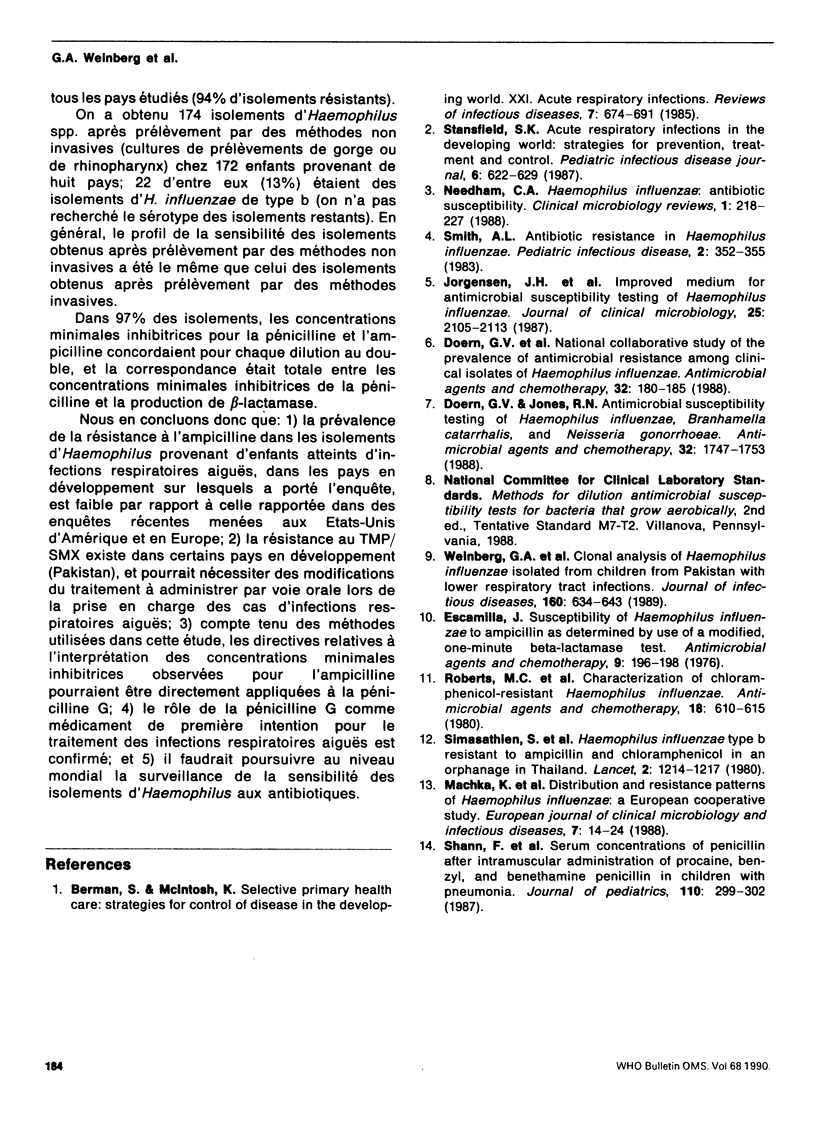Abstract
The antimicrobial susceptibilities of 426 isolates of Haemophilus species, which were collected as part of a worldwide study of the etiology of acute respiratory disease in children in selected developing countries, were determined. Eleven antibiotics were tested using the recently described Haemophilus Test Medium. There was a low prevalence of antibiotic resistance; 6% of strains were resistant to ampicillin, and 1.6% were resistant to chloramphenicol. Strains resistant to both ampicillin and chloramphenicol were recovered only from Thailand. Susceptibility to penicillin G was also determined; the minimum inhibitory concentrations for penicillin and ampicillin were concordant within one 2-fold dilution in 97% of the isolates. Thus, Haemophilus isolates were as susceptible to penicillin G as they were to ampicillin, and penicillin resistance was infrequent overall. These data provide support for the current protocols for the management of acute respiratory infections in children in developing countries, in which penicillin G is a first-line agent.
Full text
PDF





Selected References
These references are in PubMed. This may not be the complete list of references from this article.
- Berman S., McIntosh K. Selective primary health care: strategies for control of disease in the developing world. XXI. Acute respiratory infections. Rev Infect Dis. 1985 Sep-Oct;7(5):674–691. doi: 10.1093/clinids/7.5.674. [DOI] [PubMed] [Google Scholar]
- Doern G. V., Jones R. N. Antimicrobial susceptibility testing of Haemophilus influenzae, Branhamella catarrhalis, and Neisseria gonorrhoeae. Antimicrob Agents Chemother. 1988 Dec;32(12):1747–1753. doi: 10.1128/aac.32.12.1747. [DOI] [PMC free article] [PubMed] [Google Scholar]
- Doern G. V., Jorgensen J. H., Thornsberry C., Preston D. A., Tubert T., Redding J. S., Maher L. A. National collaborative study of the prevalence of antimicrobial resistance among clinical isolates of Haemophilus influenzae. Antimicrob Agents Chemother. 1988 Feb;32(2):180–185. doi: 10.1128/aac.32.2.180. [DOI] [PMC free article] [PubMed] [Google Scholar]
- Escamilla J. Susceptibility of Haemophilus influenza to ampicillin as determined by use of a modified, one-minute beta-lactamase test. Antimicrob Agents Chemother. 1976 Jan;9(1):196–198. doi: 10.1128/aac.9.1.196. [DOI] [PMC free article] [PubMed] [Google Scholar]
- Jorgensen J. H., Redding J. S., Maher L. A., Howell A. W. Improved medium for antimicrobial susceptibility testing of Haemophilus influenzae. J Clin Microbiol. 1987 Nov;25(11):2105–2113. doi: 10.1128/jcm.25.11.2105-2113.1987. [DOI] [PMC free article] [PubMed] [Google Scholar]
- Machka K., Braveny I., Dabernat H., Dornbusch K., Van Dyck E., Kayser F. H., Van Klingeren B., Mittermayer H., Perea E., Powell M. Distribution and resistance patterns of Haemophilus influenzae: a European cooperative study. Eur J Clin Microbiol Infect Dis. 1988 Feb;7(1):14–24. doi: 10.1007/BF01962165. [DOI] [PubMed] [Google Scholar]
- Needham C. A. Haemophilus influenzae: antibiotic susceptibility. Clin Microbiol Rev. 1988 Apr;1(2):218–227. doi: 10.1128/cmr.1.2.218. [DOI] [PMC free article] [PubMed] [Google Scholar]
- Roberts M. C., Swenson C. D., Owens L. M., Smith A. L. Characterization of chloramphenicol-resistant Haemophilus influenzae. Antimicrob Agents Chemother. 1980 Oct;18(4):610–615. doi: 10.1128/aac.18.4.610. [DOI] [PMC free article] [PubMed] [Google Scholar]
- Shann F., Linnemann V., Gratten M. Serum concentrations of penicillin after intramuscular administration of procaine, benzyl, and benethamine penicillin in children with pneumonia. J Pediatr. 1987 Feb;110(2):299–302. doi: 10.1016/s0022-3476(87)80177-4. [DOI] [PubMed] [Google Scholar]
- Simasathien S., Duangmani C., Echeverria P. Haemophilus influenzae type B resistant to ampicillin and chloramphenicol in an orphanage in Thailand. Lancet. 1980 Dec 6;2(8206):1214–1217. doi: 10.1016/s0140-6736(80)92478-2. [DOI] [PubMed] [Google Scholar]
- Smith A. L. Antibiotic resistance in Haemophilus influenzae. Pediatr Infect Dis. 1983 Sep-Oct;2(5):352–355. doi: 10.1097/00006454-198309000-00003. [DOI] [PubMed] [Google Scholar]
- Weinberg G. A., Ghafoor A., Ishaq Z., Nomani N. K., Kabeer M., Anwar F., Burney M. I., Qureshi A. W., Musser J. M., Selander R. K. Clonal analysis of Hemophilus influenzae isolated from children from Pakistan with lower respiratory tract infections. J Infect Dis. 1989 Oct;160(4):634–643. doi: 10.1093/infdis/160.4.634. [DOI] [PubMed] [Google Scholar]


